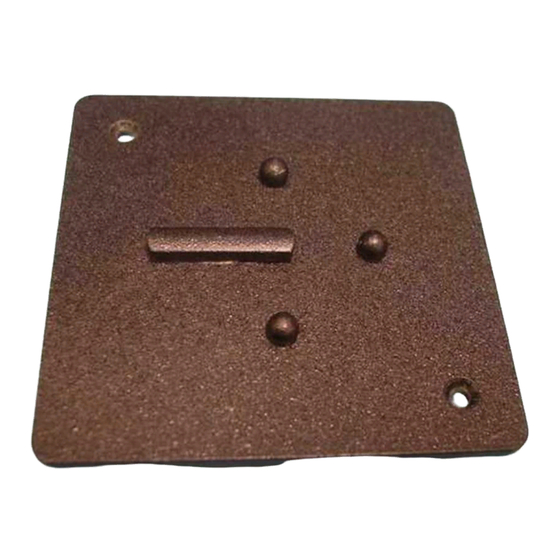
Advertisement
Quick Links
®
PZM-20R
®
PZM-20RW
T
he PZM-20R is a Pressure Zone
Microphone
®
designed for perma-
nent flush-mounting in tables, lec-
terns, pulpits, and judicial benches. Its un-
obtrusive appearance and hemispherical
pickup pattern make it ideal for conference
table use. The microphone fits into a
4.59-in. (11.659-cm) square hole or in a
standard 4.0-in. x 4.0-in. (10.16-cm x 10.16-
cm) electrical outlet box.
Electronics in the base of the 20R adapt the
microphone for phantom powering. No ex-
ternal power-supply interface is required.
The microphone plugs directly into a phan-
tom power supply providing 12 to 48 volts.
The wide-range frequency response of the
20R is emphasized at high frequencies for
clarity and articulation. Low frequencies be-
low the voice range are filtered out to reduce
rumble.
Three small guard-posts prevent papers
from sliding underneath the cantilever arm
and altering the frequency response.
Like other Pressure Zone Microphones, the
20R utilizes the Pressure Recording Pro-
cess™ in which a miniature condenser mi-
crophone capsule is arranged very close to a
sound-reflecting plate or boundary, The cap-
sule is mounted in the "Pressure Zone" just
above the boundary, a region where sound
coming directly from the sound source com-
bines in-phase with sound reflected off the
boundary. The benefits are a wide, smooth
frequency response free of phase interfer-
ence, excellent clarity and "reach," a hemi-
spherical polar pattern, and uncolored
off-axis response.
Suggestions For Use
The PZM-20R differs from other PZMs in
that it is a stationary microphone, generally
not moved from one location to another. Be-
fore installing it, first check that the pickup
will be adequate by testing a regular PZM
placed where you plan to install the 20R.
Avoid areas where items might be placed on
top of the microphone. Once you've decided
on the microphone position, rout a recessed
hole according to the dimensions in Fig. 2B
on the reverse side.
PRESSURE
ZONE
MICROPHONE
®
Specifications
Type: Pressure Zone Microphone
®
.
Element: Electret condenser.
Frequency response (typical): 80 Hz to 20 kHz (see
Fig. 1).
Polar pattern: Hemispherical on an infinite plane.
Open circuit sensitivity: 7 mV/Pa* (–43 dB re 1
volt/Pa).
Power sensitivity: –43 dB re 1 mW/Pa. EIA sensi-
tivity –135 dBm.
Impedance: 240 ohms balanced. Recommended
minimum load impedance 1000 ohms.
Equivalent noise level: 20 dB SPL (0 dB = 0.0002
dyne/cm
2
), A-weighted.
S/N ratio: 74 dB at 94 dB SPL.
Maximum SPL: 150 dB SPL at the microphone pro-
duces 3% THD.
Polarity: Positive pressure on the diaphragm pro-
duces positive voltage on terminal 2 with respect
to terminal 3 of the output terminal strip.
Operating voltage: Phantom power, 12 to 48 volts
DC, positive voltage on terminals 2 and 3 with
respect to terminal 1 of the output terminal strip.
Current drain: 1.1 mA.
Color: Black.
Connector: Screw terminals. #1 shield, #2 audio in-
polarity, #3 audio return.
Cable: None supplied; use 2-conductor shielded
microphone cable.
Weight: 8.1 ounces (230 grams).
Dimensions: See Figs. 2A and 2B.
Optional accessories: Crown PH-1A phantom
power supply (single channel, battery or AC
adapter powered), Crown PH-4B phantom power
supply (4 channels, AC powered).
*1 pascal = 10 dynes/cm
2
= 10 microbars = 94 dB SPL.
Fig. 1
Frequency Response
+15
+10
+5
dB 0
5
10
15
20
25
30
35
20
100
1K
Frequency in Hz
Low frequency response depends on size of surface.
Fig 2A
.250 in.
.635 cm
1.1 in.
2.695 cm
4.58 in.
11.63 cm
3.42 in.
8.69 cm
3.42 in.
8.69 cm
10K
.187 in.
.475 cm
4.58 in.
11.63 cm
Advertisement

Summary of Contents for Crown PZM-20R
- Page 1 Cable: None supplied; use 2-conductor shielded microphone cable. Suggestions For Use Weight: 8.1 ounces (230 grams). The PZM-20R differs from other PZMs in Dimensions: See Figs. 2A and 2B. that it is a stationary microphone, generally Optional accessories: Crown PH-1A phantom not moved from one location to another.
- Page 2 If your mixer or recorder does not provide (4) PILOT HOLES FOR ROUTER phantom powering, you’ll need a micro- Crown professional microphones are guar- phone power supply. Crown offers a model TABLE anteed unconditionally against malfunction 4.59 in. (11.659 cm) SQUARE...











Need help?
Do you have a question about the PZM-20R and is the answer not in the manual?
Questions and answers